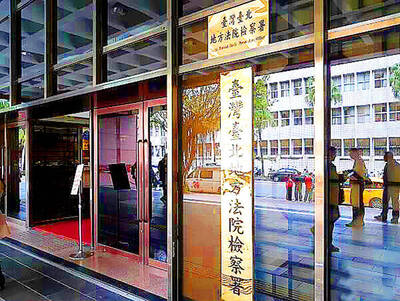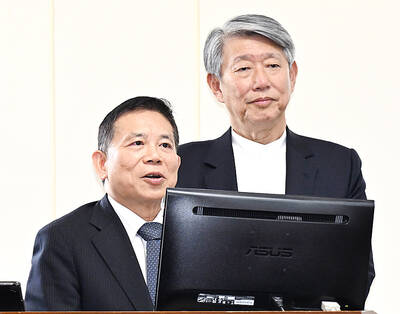South Korea yesterday said that it has extended its air defense zone to partially overlap with a similar zone declared by China two weeks ago that has sharply raised regional tensions.
Beijing’s declaration of an air defense identification zone (ADIZ) in an area that includes islands at the heart of a territorial dispute with Taiwan and Japan has triggered protests from the US, as well as close allies Japan and South Korea.
Announcing the expansion of its own zone to include two territorial islands to the south and a submerged rock also claimed by China, the South Korean Ministry of Defense said the move would not infringe on neighboring countries’ sovereignty.
“We believe this will not significantly impact our relationships with China and with Japan as we try to work for peace and cooperation in Northeast Asia,” the ministry’s head of policy, Jang Hyuk, told a briefing.
“We have explained our position to related countries and overall they are in agreement that this move complies with international regulations and is not an excessive measure,” he said, adding that the ministry’s top priority was to work with neighboring countries to prevent military confrontation.
South Korea objected to China’s Nov. 23 move as unacceptable because its new zone includes a maritime rock named Ieodo, which Seoul controls and has a research station platform built atop it.
China also claims the submerged rock.
However, Seoul’ reaction to Beijing has been more measured than the sharp rebukes delivered by Tokyo and Washington, reflecting a sensitivity toward South Korea’s largest trading partner.
South Korea’s air defense zone was originally established by the US Air Force in 1951 during the Korean War.
Its extension will not apply any restrictions to the operation of commercial flights, the ministry said separately in a statement. The move will take effect on Sunday, it said.
It will also result in an overlap with Japan’s air defense zone, Jang said.
There was no immediate reaction from China, although Beijing’s response to news last week that South Korea was reviewing its options on the ADIZ was relatively low-key.
Chinese Ministry of Foreign Affairs spokesman Hong Lei (洪磊) on Friday said any move by South Korea must “accord with international law and norms.”
However, Hong added: “China is willing to maintain communications with South Korea on the basis of equality and mutual respect.”
The decision by China that kicked off the latest spat was the subject of a tense disagreement, as US Vice President Joe Biden visited China, stressing Washington’s objections to the move that he said caused “significant apprehension” in the region.
Beijing says its zone is in accordance with international law and Washington and others should respect it.
Under the Chinese zone’s rules, all aircraft have to report flight plans to Chinese authorities, maintain radio contact and reply promptly to identification inquiries.
US, Japanese and South Korean military aircraft have breached the zone without informing Beijing since it was announced.
South Korean and Japanese commercial planes have also been advised by their governments not to follow the rules.

INVESTIGATION: The case is the latest instance of a DPP figure being implicated in an espionage network accused of allegedly leaking information to Chinese intelligence Democratic Progressive Party (DPP) member Ho Jen-chieh (何仁傑) was detained and held incommunicado yesterday on suspicion of spying for China during his tenure as assistant to then-minister of foreign affairs Joseph Wu (吳釗燮). The Taipei District Prosecutors’ Office said Ho was implicated during its investigation into alleged spying activities by former Presidential Office consultant Wu Shang-yu (吳尚雨). Prosecutors said there is reason to believe Ho breached the National Security Act (國家安全法) by leaking classified Ministry of Foreign Affairs information to Chinese intelligence. Following interrogation, prosecutors petitioned the Taipei District Court to detain Ho, citing concerns over potential collusion or tampering of evidence. The

NEGOTIATIONS: Taiwan has good relations with Washington and the outlook for the negotiations looks promising, Minister of Economic Affairs J.W. Kuo said Taiwan’s GDP growth this year is expected to decrease by 0.43 to 1.61 percentage points due to the effects of US tariffs, National Development Council (NDC) Minister Paul Liu (劉鏡清) said at a meeting of the legislature’s Economics Committee in Taipei yesterday, citing a preliminary estimate by a private research institution. Taiwan’s economy would be significantly affected by the 32 percent “reciprocal” tariffs slapped by the US, which took effect yesterday, Liu said, adding that GDP growth could fall below 3 percent and potentially even dip below 2 percent to 1.53 percent this year. The council has commissioned another institution

NEGOTIATIONS: The US response to the countermeasures and plans Taiwan presented has been positive, including boosting procurement and investment, the president said Taiwan is included in the first group for trade negotiations with the US, President William Lai (賴清德) said yesterday, as he seeks to shield Taiwanese exporters from a 32 percent tariff. In Washington, US Trade Representative Jamieson Greer said in an interview on Fox News on Thursday that he would speak to his Taiwanese and Israeli counterparts yesterday about tariffs after holding a long discussion with the Vietnamese earlier. US President Donald Trump on Wednesday postponed punishing levies on multiple trade partners, including Taiwan, for three months after trillions of US dollars were wiped off global markets. He has maintained a 10 percent

TRADE: The premier pledged safeguards on ‘Made in Taiwan’ labeling, anti-dumping measures and stricter export controls to strengthen its position in trade talks Products labeled “made in Taiwan” must be genuinely made in Taiwan, Premier Cho Jung-tai (卓榮泰) said yesterday, vowing to enforce strict safeguards against “origin laundering” and initiate anti-dumping investigations to prevent China dumping its products in Taiwan. Cho made the remarks in a discussion session with representatives from industries in Kaohsiung. In response to the US government’s recent announcement of “reciprocal” tariffs on its trading partners, President William Lai (賴清德) and Cho last week began a series of consultations with industry leaders nationwide to gather feedback and address concerns. Taiwanese and US officials held a videoconference on Friday evening to discuss the